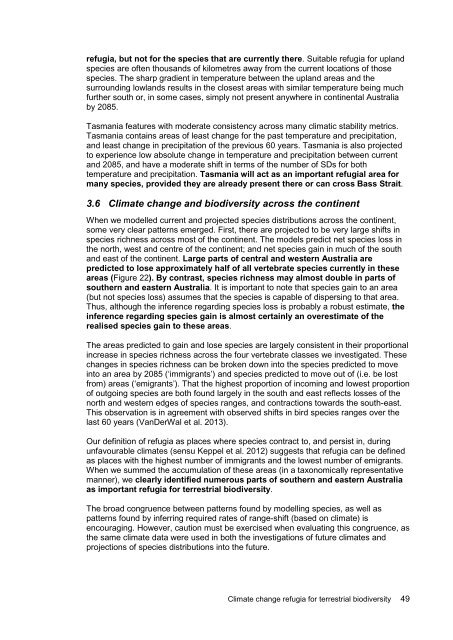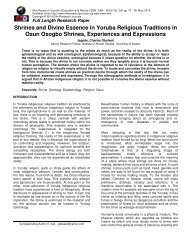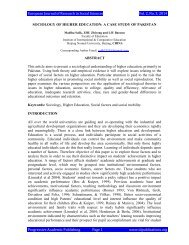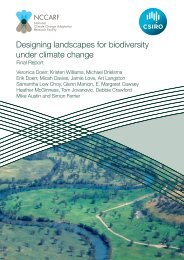Williams-Climate-change-refugia-for-terrestrial-biodiversity_0
Williams-Climate-change-refugia-for-terrestrial-biodiversity_0
Williams-Climate-change-refugia-for-terrestrial-biodiversity_0
Create successful ePaper yourself
Turn your PDF publications into a flip-book with our unique Google optimized e-Paper software.
efugia, but not <strong>for</strong> the species that are currently there. Suitable <strong>refugia</strong> <strong>for</strong> upland<br />
species are often thousands of kilometres away from the current locations of those<br />
species. The sharp gradient in temperature between the upland areas and the<br />
surrounding lowlands results in the closest areas with similar temperature being much<br />
further south or, in some cases, simply not present anywhere in continental Australia<br />
by 2085.<br />
Tasmania features with moderate consistency across many climatic stability metrics.<br />
Tasmania contains areas of least <strong>change</strong> <strong>for</strong> the past temperature and precipitation,<br />
and least <strong>change</strong> in precipitation of the previous 60 years. Tasmania is also projected<br />
to experience low absolute <strong>change</strong> in temperature and precipitation between current<br />
and 2085, and have a moderate shift in terms of the number of SDs <strong>for</strong> both<br />
temperature and precipitation. Tasmania will act as an important <strong>refugia</strong>l area <strong>for</strong><br />
many species, provided they are already present there or can cross Bass Strait.<br />
3.6 <strong>Climate</strong> <strong>change</strong> and <strong>biodiversity</strong> across the continent<br />
When we modelled current and projected species distributions across the continent,<br />
some very clear patterns emerged. First, there are projected to be very large shifts in<br />
species richness across most of the continent. The models predict net species loss in<br />
the north, west and centre of the continent; and net species gain in much of the south<br />
and east of the continent. Large parts of central and western Australia are<br />
predicted to lose approximately half of all vertebrate species currently in these<br />
areas (Figure 22). By contrast, species richness may almost double in parts of<br />
southern and eastern Australia. It is important to note that species gain to an area<br />
(but not species loss) assumes that the species is capable of dispersing to that area.<br />
Thus, although the inference regarding species loss is probably a robust estimate, the<br />
inference regarding species gain is almost certainly an overestimate of the<br />
realised species gain to these areas.<br />
The areas predicted to gain and lose species are largely consistent in their proportional<br />
increase in species richness across the four vertebrate classes we investigated. These<br />
<strong>change</strong>s in species richness can be broken down into the species predicted to move<br />
into an area by 2085 (‘immigrants’) and species predicted to move out of (i.e. be lost<br />
from) areas (‘emigrants’). That the highest proportion of incoming and lowest proportion<br />
of outgoing species are both found largely in the south and east reflects losses of the<br />
north and western edges of species ranges, and contractions towards the south-east.<br />
This observation is in agreement with observed shifts in bird species ranges over the<br />
last 60 years (VanDerWal et al. 2013).<br />
Our definition of <strong>refugia</strong> as places where species contract to, and persist in, during<br />
unfavourable climates (sensu Keppel et al. 2012) suggests that <strong>refugia</strong> can be defined<br />
as places with the highest number of immigrants and the lowest number of emigrants.<br />
When we summed the accumulation of these areas (in a taxonomically representative<br />
manner), we clearly identified numerous parts of southern and eastern Australia<br />
as important <strong>refugia</strong> <strong>for</strong> <strong>terrestrial</strong> <strong>biodiversity</strong>.<br />
The broad congruence between patterns found by modelling species, as well as<br />
patterns found by inferring required rates of range-shift (based on climate) is<br />
encouraging. However, caution must be exercised when evaluating this congruence, as<br />
the same climate data were used in both the investigations of future climates and<br />
projections of species distributions into the future.<br />
<strong>Climate</strong> <strong>change</strong> <strong>refugia</strong> <strong>for</strong> <strong>terrestrial</strong> <strong>biodiversity</strong> 49






